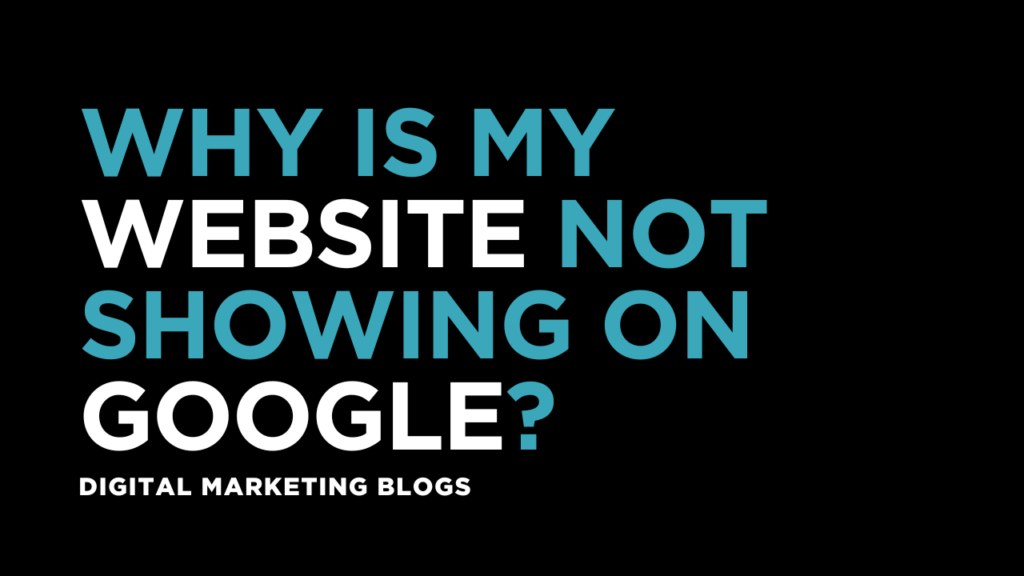After launching a website, one of the most frustrating problems is not seeing it appear in Google search results. Whether you’re searching by brand name or keywords, the absence can feel confusing and concerning.
If you’re facing this issue, you’re not alone. There are several reasons your website might not be showing up, and most of them are fixable. This guide breaks down the most common causes and how to resolve them.
1. Your Website Hasn’t Been Indexed Yet
Google doesn’t automatically know when a new website goes live. It needs to find, crawl, and index your pages before they can appear in search results.
How to Check
Search this in Google:site:yourdomain.com
If nothing appears, your site has likely not been indexed yet.
What to Do
-
Submit your website to Google Search Console
-
Request indexing for your homepage and other key URLs
-
Create and submit a sitemap
-
Make sure your website is accessible without login or restrictions
New websites may take a few days to a few weeks to be indexed, depending on crawl frequency and authority.
2. Your Website Is Blocked by Robots.txt or Meta Tags
Sometimes developers unintentionally block search engines from crawling the site through a misconfigured robots.txt file or noindex tags.
What to Check
-
Open yourdomain.com/robots.txt
-
Look for
Disallow: /which prevents all crawling -
Check your HTML for
<meta name="robots" content="noindex">
How to Fix
-
Update robots.txt to allow crawling
-
Remove noindex tags from pages you want to show up
-
Revalidate changes in Google Search Console
3. Your Website Is Too New
Even if everything is configured correctly, Google may take time to trust and rank your website. A new site usually lacks backlinks, content history, and domain authority.
Tips to Speed It Up
-
Build high-quality backlinks from trusted sources
-
Share your site on social media and relevant communities
-
Add your business to local directories
-
Keep publishing valuable, original content
Patience and consistency are key in the early stages.
4. Your Site Has Poor SEO Structure
Google relies on a clear website structure to understand what your pages are about. If your site lacks proper headings, meta tags, or clean URLs, it may struggle to rank.
Best Practices
-
Use unique title and meta descriptions for every page
-
Structure content with H1, H2, and H3 headings
-
Avoid keyword stuffing
-
Ensure all pages are internally linked
-
Use readable URLs (e.g., yourdomain.com/services/web-design)
Technical SEO helps search engines index and rank your pages correctly.
5. There’s Little or No Content
Thin content or a lack of pages can prevent Google from recognizing your website as useful or relevant.
How to Improve
-
Add service pages, blog posts, FAQs, and testimonials
-
Focus on topics your audience searches for
-
Use keywords naturally within your content
-
Include internal and external links where relevant
Google prioritizes websites that offer real value and depth.
6. Your Website Isn’t Mobile-Friendly
Google now uses mobile-first indexing, which means it evaluates the mobile version of your site first. A site that performs poorly on smartphones may be penalized.
How to Check
Use Google’s Mobile-Friendly Test to see how your site performs.
Fixes Include
-
Using responsive design
-
Ensuring text is readable without zoom
-
Fixing overlapping elements or buttons
-
Speeding up mobile load times
A mobile-optimized site improves both SEO and user experience.
7. Slow Page Speed or Technical Issues
Page speed is a ranking factor. If your website loads slowly or has technical errors, Google may deprioritize it in search results.
Common Causes
-
Large image sizes
-
Too many plugins or scripts
-
Server response delays
-
Broken links or redirects
What to Do
-
Use tools like PageSpeed Insights or GTmetrix
-
Compress images and enable browser caching
-
Fix broken links and 404 errors
-
Choose a reliable hosting provider
Faster websites rank better and keep users engaged.
8. Google Penalties or Manual Actions
If your site violates Google’s quality guidelines, it might be removed or demoted. This could be due to spammy backlinks, keyword stuffing, duplicate content, or shady practices.
How to Check
Log into Google Search Console and review the Manual Actions section.
How to Recover
-
Identify and remove harmful content or links
-
Submit a reconsideration request after making changes
-
Avoid black-hat SEO tactics going forward
Penalties can be reversed with corrective action.
9. No Backlinks or Off-Page Signals
Backlinks act as votes of confidence. If no other sites are linking to yours, Google may not consider it trustworthy or relevant.
How to Gain Backlinks
-
Submit to local business directories
-
Guest post on relevant blogs
-
Collaborate with industry partners
-
Share valuable content that others want to reference
Authority builds over time through consistent promotion and quality work.
10. Your Keywords Are Too Competitive
Even if your site is indexed, it may not appear on the first few pages of search results for popular keywords. Larger, older sites often dominate competitive search terms.
Smart Strategy
-
Focus on long-tail keywords with lower competition
-
Include local keywords to narrow down search intent
-
Target niche topics where you can provide expert insight
Over time, you can expand into broader keyword territory.
A Local Perspective on Website Visibility
For businesses in Kerala, the competitive landscape includes both national and regional players. Hiring a skilled web developer in Calicut can help you optimize for local SEO, improve site performance, and implement the technical best practices Google expects.
Local expertise ensures your website appeals not just to search engines, but to the specific audience you’re targeting.
Final Thoughts
If your website isn’t showing on Google, the good news is that most issues are solvable. Start by verifying index status, then address technical barriers, SEO structure, and content quality.
Focus on building a strong foundation rather than chasing shortcuts. Search visibility improves through a combination of time, relevance, and trust.



